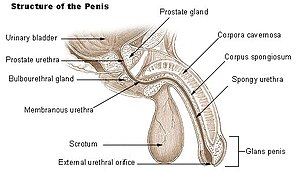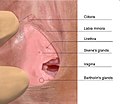Difference between revisions of "Urinary meatus"
(created from WP) |
m (adjust REFs) |
||
| Line 10: | Line 10: | ||
[[Meatal stenosis]] is a late complication of circumcision, which occurs in about 10–20 percent of newborn circumcised boys after the loss of the protection of the [[foreskin]].<ref name ="CPS">{{REFjournal | [[Meatal stenosis]] is a late complication of circumcision, which occurs in about 10–20 percent of newborn circumcised boys after the loss of the protection of the [[foreskin]].<ref name ="CPS">{{REFjournal | ||
|last=Sorokan | |last=Sorokan | ||
| + | |first=S. Todd | ||
|init=SK | |init=SK | ||
|last2=Finlay | |last2=Finlay | ||
| + | |first2=Jane C. | ||
|init2=JC | |init2=JC | ||
|last3=Jefferies | |last3=Jefferies | ||
| − | |init3= | + | |first3=Ann L. |
| + | |init3=AL | ||
|title=Newborn male circumcision | |title=Newborn male circumcision | ||
| + | |url=https://pubmed.ncbi.nlm.nih.gov/26435672/ | ||
|journal=Paediatr Child Health | |journal=Paediatr Child Health | ||
| − | |date=2015 | + | |publisher=Canadian Paediatric Society, Fetus and Newborn Committee, Infectious Diseases and Immunization Committee |
| + | |date=2015-09 | ||
| + | |accessdate=2022-01-19 | ||
|volume=20 | |volume=20 | ||
|issue=6 | |issue=6 | ||
|pages=311–5 | |pages=311–5 | ||
| − | |||
|DOI=10.1093/pch/20.6.311 | |DOI=10.1093/pch/20.6.311 | ||
|pubmedID=26435672 | |pubmedID=26435672 | ||
| Line 81: | Line 86: | ||
|publisher=IntechOpen | |publisher=IntechOpen | ||
|DOI=10.5772/22301 | |DOI=10.5772/22301 | ||
| + | |accessdate=2022-01-19 | ||
}}</ref><br clear=left> | }}</ref><br clear=left> | ||
Revision as of 15:37, 19 January 2022
(The following text or part of it is quoted from the free Wikipedia article Urinary meatus
:)
The urinary meatus, also known as the external urethral orifice, is the opening of the urethra. (Meatus refers to a tubular opening or passage in the body. From Latin meātus: a course, passing.) It is the point where urine exits the urethra in both sexes and where semen exits the urethra in males. The meatus has varying degrees of sensitivity to touch. The meatus is located on the glans of the penis or in the vulval vestibule.
Contents
In human males
The male external urethral orifice is the external opening or urinary meatus, normally located at the tip of the glans penis, at its junction with the frenular delta. It presents as a vertical slit, possibly bounded on either side by two small labia-like projections, and continues longitudinally along the front aspect of the glans, which facilitates the flow of urine micturition. In some cases, the opening may be more rounded. This can occur naturally or may also occur as a side effect of excessive skin removal during circumcision. The meatus is a sensitive part of the male reproductive system.
Meatal stenosis is a late complication of circumcision, which occurs in about 10–20 percent of newborn circumcised boys after the loss of the protection of the foreskin.[1]
In human females
The female external urethral orifice is the external opening of the urethra, from which urine is ejected during urination. It is located about 2.5 cm (1 in) behind the clitoris and immediately in front of the vagina in the vulval vestibule. It usually assumes the form of a short, sagittal cleft with slightly raised margins. To its left and right are the openings of the Skene's glands.
Some evidence exists to suggest that the clitoral-urinary meatus distance (CUMD) in human females relates to the ease with which the female may achieve orgasm through penetrative sex. Orgasm from penetration alone is observed to be more likely as CUMD decreases.[2]
Evidence also suggests that decreased distance from the vaginal opening to the urethral meatus is associated with recurrent post-coital urinary tract infections. [3] Surgical repositioning of the distal urethra to prevent recurrent post-coital urinary tract infections has been employed with some success by Russian physicians.[4]
Clinical significance
Congenital disorders of the meatus, in the male, include epispadias (the misplacement to the upper aspect) and hypospadias (the misplacement to the underside of the penis). A congenital misshaping can result in its narrowing (meatal stenosis), causing a partial or total urinary blockage or the bifurcation of the urinary stream. A urethral blockage can also be caused by foreign material, kidney stones, or bladder stones (lithiasis).
Additional images
References
- ↑
 Sorokan SK, Finlay JC, Jefferies AL. (Canadian Paediatric Society, Fetus and Newborn Committee, Infectious Diseases and Immunization Committee) Newborn male circumcision. Paediatr Child Health. September 2015; 20(6): 311–5. PMID. PMC. DOI. Retrieved 19 January 2022.
Sorokan SK, Finlay JC, Jefferies AL. (Canadian Paediatric Society, Fetus and Newborn Committee, Infectious Diseases and Immunization Committee) Newborn male circumcision. Paediatr Child Health. September 2015; 20(6): 311–5. PMID. PMC. DOI. Retrieved 19 January 2022.
- ↑
 Wallen K, Lloyd EA. Female Sexual Arousal: Genital Anatomy and Orgasm in Intercourse. Hormones and Behavior. 13 March 2017; 59(5): 780–92. PMID. PMC. DOI.
Wallen K, Lloyd EA. Female Sexual Arousal: Genital Anatomy and Orgasm in Intercourse. Hormones and Behavior. 13 March 2017; 59(5): 780–92. PMID. PMC. DOI.
- ↑
 Gyftopoulos K, Matkaris M. Clinical implications of the anatomical position of the urethra meatus in women with recurrent post-coital cystitis: a case-control study. Int Urogynecol J. 2019; 30(8): 1351-7. PMID. DOI.
Gyftopoulos K, Matkaris M. Clinical implications of the anatomical position of the urethra meatus in women with recurrent post-coital cystitis: a case-control study. Int Urogynecol J. 2019; 30(8): 1351-7. PMID. DOI.
- ↑
 Sumerova N, Pushkar D, Gvozdev M:
Sumerova N, Pushkar D, Gvozdev M: Transposition of Distal Urethra in Female Patients with Recurrent Lower UTI Associated with Sexual Intercourse
, in: Clinical Management of Complicated Urinary Tract Infection. Ahmad Nikibakhsh (ed.). IntechOpen. Retrieved 19 January 2022.


